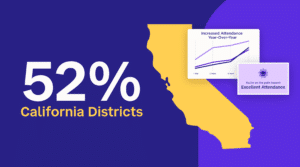
Featured Resource
Why Over Half of California School Districts Trust SchoolStatus
Read More >Join Mission: Attendance to reduce chronic absenteeism in 2025-26! >> Learn How <<





We reached out to educators to understand their priorities as we embark on the 2023-2024 academic year. Their insights shed light on the common challenges faced by districts everywhere as school gets underway.
When asked about their primary goals, an impressive 75% of respondents highlighted the importance of “Establishing a Communication Routine.” This goal is like the cornerstone of a successful school year. Why? Because positive, consistent school-home communication builds trust, leading to improved attendance, academic performance, behavior, and social-emotional skills. A recent study even revealed that students who had the best outcomes during remote learning had the highest levels of trust in their community. So, establishing a communication rhythm is a fantastic goal for the new school year. One way to approach it is to think of it as a funnel ????:
Every family should receive the full funnel regularly. Set a consistent schedule, and stick to it.
Coming in at #2, 55% of respondents mentioned “Getting enough sleep” as one of their top 2-3 goals. Absolutely! We can’t be at our best without adequate rest. It’s not only acceptable but also essential to prioritize self-care. Close that laptop, don’t check that email, and put off texting your work buddy. Prioritizing yourself sets an example of healthy practices for everyone around you.
Embrace self-care. Switch off the lights and get a good night’s sleep. Every night.

A significant 71% of respondents identified, “Reaching all families with back-to-school information and communication” as their top challenge. Getting crucial information to families is directly tied to student success, but it’s not so easy. Families speak various languages, access information differently, and some face housing instability. However, for successful learning recovery, we must ensure that kids come to school. The first step is delivering information to families and guardians effectively. To achieve this, districts need a multifaceted approach. A single email won’t suffice.
Attendance also benefits from a funnel approach. Top of the funnel is clear, positive guidance in different languages on the importance of attendance from district leadership. Middle of the funnel is translatable group messages to classes or grades, with information and expectations. And the bottom of the funnel finds teachers, advisors, and/or counselors engaging in one-to-one outreach.
Following the challenge of reaching all families, the next most common concern was “Establishing attendance as a value,” chosen by 45% of respondents. There’s solid evidence that punitive approaches to attendance, such as truancy, backfire on students. Instead of encouraging attendance, it discourages it. Why? Because students need to feel that someone at school cares about their presence. Positive outreach is the key. Nobody wants to show up somewhere only to receive a scolding. Promoting attendance as a core value can take many forms, from weekly shoutouts in teacher or principal updates to creating a “hall of fame” in the front office, hosting pizza parties, or sending district-wide materials in various languages. Creating a culture of showing up means educating students and families about the importance of coming to school.
It also means making school a place where students want to be.
The responses to this question were truly insightful. Here are a few tips related to educators’ top goals and challenges:
In sum: communicate early and often. Take care of you. Have a fantastic year. Thank you to all the dedicated educators who participated in our survey and shared their valuable ideas.
And always remember, our SchoolStatus team is here to assist you in any way we can!
 Dr. Kara Stern
Dr. Kara SternDirector, Education and Engagement
Dr. Kara Stern began her career as an ELA teacher, then shifted into administration as a middle school principal. Dr. Stern is a fervent advocate for equitable communication and family engagement. She spent five years as Executive Director at Math for America, where she designed the professional learning community that exists to this day. An unexpected move to Tel Aviv launched her into the world of EdTech where she became the Director of Education Content for Smore and then the Head of Content at SchoolStatus. Outside of work, she indulges her love for reading, devouring two novels weekly, with a particular fondness for heists and spy stories.
News, articles, and tips for meeting your district’s goals—delivered to your inbox.






Ready to learn more about our suite of solutions?
